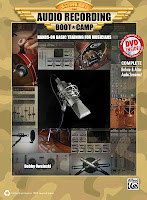This lack of craft doesn't have to be so, and anyone who puts a little time and thought into it can probably beat out the typical Black Eyed Peas lyrics (who are very good at lyrical hooks, but less so with the rest). Robin Yokiko recently wrote a great article regarding the 10 Tips For Better Lyric Writing on the Music Clout blog. Here they are:
"1. Have a theme. Themes don’t make your lyrics boring, they make them cohesive. Think of "Somewhere Over the Rainbow" and its whimsical sky references (clouds, birds, stars, chimney tops). It’s about world-building that sweeps the listener away.
2. Try to stay away from perfect rhymes. Day and way. Run, fun, sun. They sometimes ring as childish, especially if the context is not interesting enough. Be more adventurous and less strict (fade and wait, mine and kind, crazy and maybe, etc.).
3. Make the context interesting. If you are singing the same old love song, say it in a different way. Build from real memories, real conversation, or unusual metaphors.
4. Put the rhymes in unusual places (internal rhymes, in the middle of phrases). It adds meat to the bones of your song.
5. Change up the rhyme scheme. An example from Pat Pattison, “Mary had a little lamb, fleece was white as snow. And everywhere that Mary went, she sold the fleece to pay the rent.”
6. Put the emphasis on the right syllable. As much as I love Alanis Morissette, she has an annoying habit of misplacing accents, making it incredibly awkward and difficult to understand (“an un-for-TU-nate slight,” instead of “un-FOR-tu-nate” in "Uninvited"). If you are dead-set on a lyric that stresses the wrong syllable, don’t be afraid to change the rhythm to set it right. You can also add or take away unimportant words like “that” or separating contractions. Personally, I know a lyric is right when it sounds as if I could speak it naturally.
7. Make your choruses more general than your verses. This is not a hard rule, but it helps to “change scenes” after your verse.
8. Be ruthless about clichés. Speak your lyrics aloud to spot them. When you find them (and you probably will), try changing only one word to something unexpected.
9. Keep writing different versions of the same section. You can always go back to the original, but you never know what you’ll come up with on try #5.
10. Don’t be afraid of the tools in your arsenal. Get a thesaurus. And a rhyming dictionary. Even if you don’t use the words you find, they can sometimes inspire other ideas. So can novels, newspapers, facebook updates, and people-watching."
Lyric writing is as an art and true masters are poets. Not everyone can attain such lofty levels, but with a little time and the use of the above tips, it's possible to rise above the mediocre.
----------------------------------
You should follow me on Twitter for daily news and updates on production and the music business.
Don't forget to check out my Music 3.0 blog for tips and tricks on navigating social media and the new music business.







